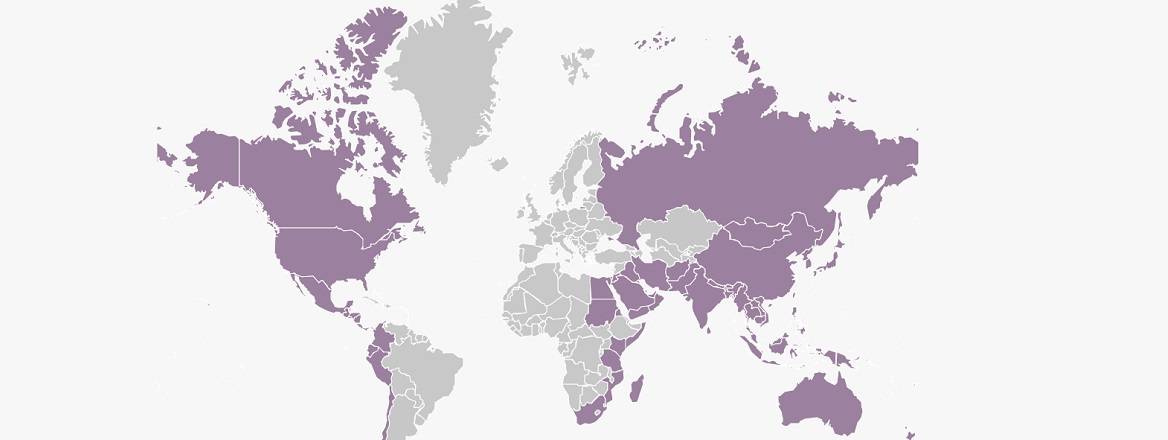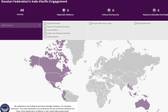About - Mapping Indo-Pacific Engagement
Mapping the engagement of Japan and the Russian Federation in the Indo-Pacific.
The project aims to provide a user-friendly interactive research tool which consolidates information on the fast-evolving relationships developing across the Indo-Pacific region. The current two maps represent Phase 1 of the project which focuses on mapping the regional engagements of Japan and the Russian Federation in the Indo-Pacific. The maps have been developed with support from the Japanese Ministry of Foreign Affairs and the Russian Strategic Initiative.
About the Project
The rise of the Indo-Pacific as a distinct regional space is seeing the emergence of broad and diversified engagement by leading international actors, often on the basis on distinct regional strategies. The Indo-Pacific is seen as both representing major opportunities but also growing risks as a result of evolving great power competition – principally between China and the United States. The idea of a distinct region is also contested by leading international actors, notably China and the Russian Federation, which argue that the idea of the Indo-Pacific is a security construction of the United States and its leading allies and partners. There are also different definitions of the scope of the region, even amongst close allies, reflecting differing ideas of national interest and understandings of the key regional dynamics.
While the concept of the Indo-Pacific is contested, the growing cohesive engagement by international actors with a wide geography of counties located around and across the Asia-Pacific and Indian Ocean sub-regions points to the emergence of distinct strategic space. For the purposes of these maps, the Indo-Pacific region consists of more than 80 countries and other territories (for example Taiwan and the Cook Islands). Data on the engagement of the United Kingdom (2017-2021), Japan (2018-2022, with selected data up to Q1 2023), and the Russian Federation (2017-2021) with these countries is presented here to assist work to clarify the emerging political, diplomatic, defence and security approaches being employed and how various bilateral and minilateral engagements are also evolving. The maps are, thus, intended to help to understand the developing complexity of the Indo-Pacific and to facilitate further analysis of the region.
Project Objectives
- To provide an evidence driven mapping of the evolving Indo-Pacific engagements of leading international actors;
- To provide a point of reference for building comparisons of the approaches to the Indo-Pacific region being taken by these actors;
- To highlight which relationships and issue areas are the priorities for the three countries across the region and how these priorities have developed in recent years.
Methodology
For the development of Phase 1 of the maps indicating the engagement of Japan and the Russian Federation with the Indo-Pacific, data has been coded and recorded for several areas, including defence and security cooperation, aid and development support, economic ties, diplomatic engagement, and interactions based on research, education, and people.
Phase 1 of this project includes data for the period 2017-2022. Incomplete data sets will be updated in future phases of the project.
All the information recorded in the map is drawn from open sources. The specific sources of information, such as official government policy documentation or media reports, are all linked within the map.
In compiling the map, official and unofficial (machine) translations of government and non-governmental sources have been employed.
Military exercises have been recorded where the selected country is either the exercise lead, where a specific capability or operational activity has been exercised or where the selected country routinely provides forces for standing exercises in the Indo-Pacific. Capacity building exercises and training undertaken across the Indo-Pacific have been recorded separately to wider exercise activity.
Defence and security dialogues have been recorded where senior ministerial or armed force leadership are the primary participants. Diplomatic engagements have been recorded at the Prime Minister or Foreign Minister level.
Mapping engagement
Here we look at how Japan and the Russian Federation have engaged with the Indo-Pacific
Supported by
The Japanese Government
The 'Mapping Japan's Engagement in the Indo-Pacific' project is supported by the Japanese Government.
Russia Strategic Initiative
This publication (Mapping the Russian Federation's Engagement in the Indo-Pacific) has been funded by the Russia Strategic Initiative, U.S. European Command. The views expressed in this publication do not necessarily represent the views of the Department of Defense or the United States government.








